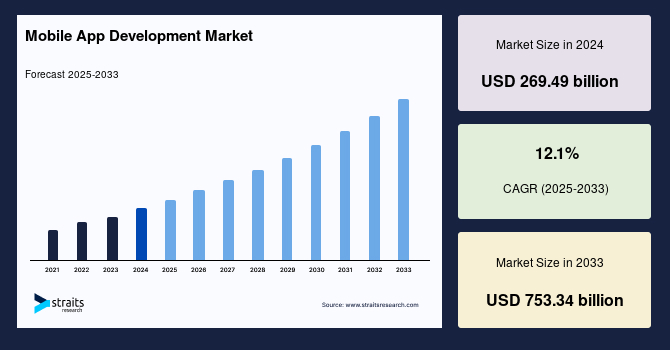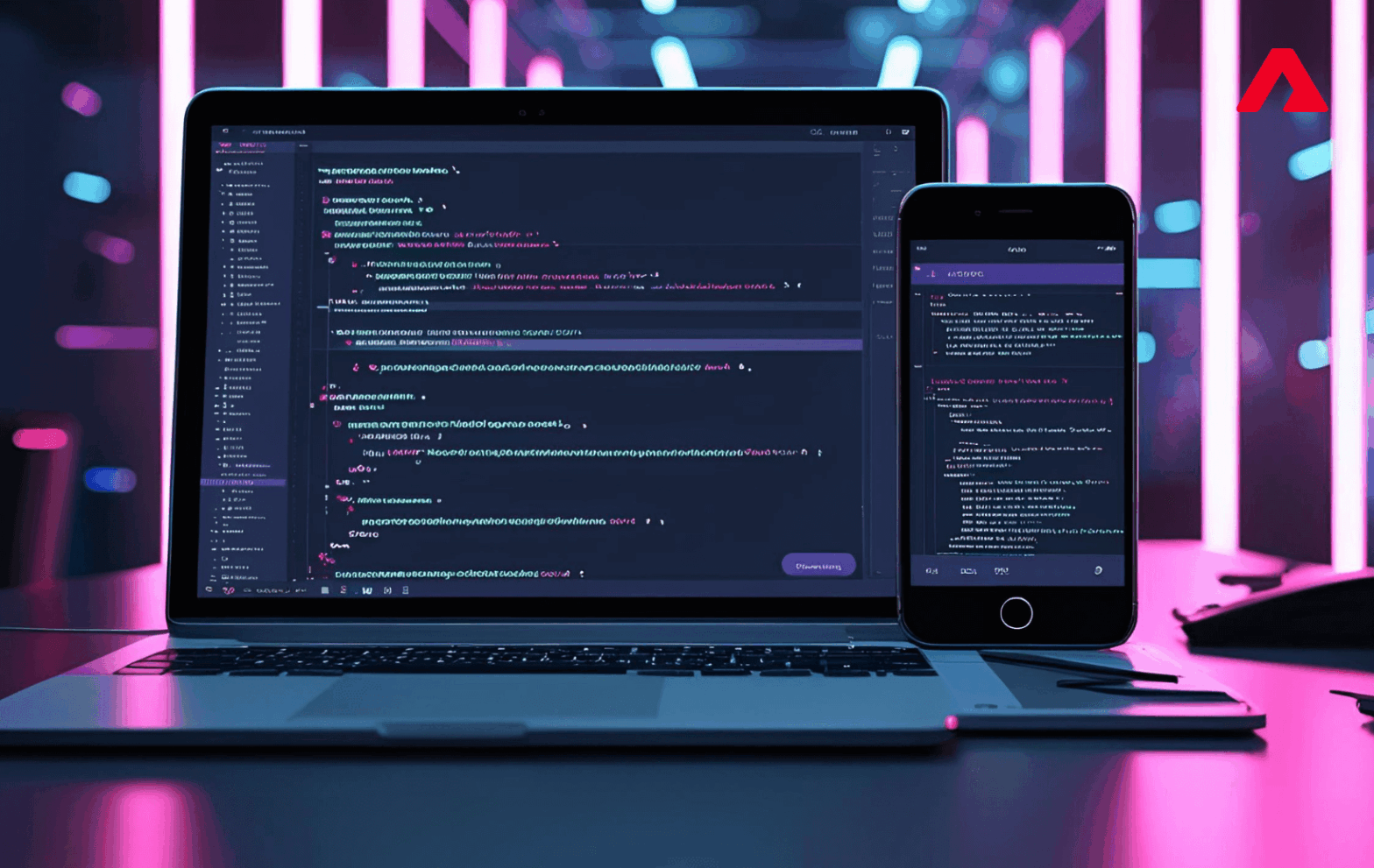Mobile phones are an integral part of our lives, and mobile applications are making everyday tasks easier. There is an app for almost everything, including entertainment, cooking, education, and more. Moreover, over time, we are also witnessing the undeniable revolution in the mobile app development realm.
According to a report by Straits Research, the global mobile application development industry is growing rapidly due to increased demand for smarter, scalable, and cross-platform applications. In 2024, the global market is valued at USD 269.49 billion and is projected to reach USD 753.34 billion by 2033, growing at a CAGR of 12.1%. This demand is increasing due to the rising need for smartphone usage in sectors like banking, education, healthcare, and e-commerce. As competition grows, mobile app development platforms (MADPs) are improving to help businesses launch apps faster.

Image Source: straitsresearch
Continue reading as this blog explores the top mobile app development platforms.
Mobile Application Development Platform (MADP)
If we look back in time, mobile app development was a difficult yet demanding task. Developers often struggled to manage multiple tools and learn entirely new technologies simultaneously. However, Mobile app development platforms (MADP) appeared as a savior; a suite of tools, services, and technologies. These platforms have reduced the complexity and significantly increased the speed of end-to-end application development. With this suite, developers are offered many high-productivity approaches, helping them tailor the app development to the market demand.
Key benefits of mobile applications development platforms:
- User-friendly interface: Developers find these platforms easy to use primarily because of the set of pre-built components and features these platforms offer. Additionally, it provides a user-friendly interface that enables a seamless end-to-end development process.
- Cross-platform compatibility: Most of the platforms offer cross-platform compatibility for creating apps using a single codebase.
- Integration with cloud-based services: Developers are heavily benefiting from the integration with cloud-based services and tools. They work on the simplified development process without needing to build and maintain their servers and infrastructure.
- Testing and debugging tools: Developers can now rigorously ensure the high-quality apps and their performance. This suite is equipped with several test and debugging tools, simulators, and emulators that offer flexibility, scalability, and control.
- Native feature accessibility: By building an app with native features, developers can ensure an inclusive digital experience for all users. These features are crucial to ensure consistent and reliable support for an app across various platforms.
- Cost-effective: for a robust and faster process, the development and maintenance costs and time play a vital role. However, with reusable code, developers can accelerate the scalability and user base, and traffic effortlessly.
- User experience: Many customization, monitoring, and analytics tools help developers to add personalization in their applications that leads to an optimum user experience.
Best Mobile Application Development Platforms
1. Native – Android / iOS :
Native app development refers to developing platform-specific applications using dedicated technologies and languages. For Android, Kotlin or Java is suitable, and for iOS, Swift or Objective-C is recommended. This approach provides seamless access to device features and ensures unmatched performance and responsiveness.
It allows developers to build highly optimised apps for the respective OS ecosystem by considering hardware capabilities. Developers get full control over design, animations, and system-level integrations with native platforms. While this approach provides multiple capabilities and features, it still requires maintaining separate codebases for Android and iOS, which can increase development time and cost.
Both Android Studio and Xcode offer robust toolsets, including simulators, debugging support, and performance profilers. With modern languages like Kotlin for Android and Swift for iOS, native development has become more efficient, safer, and scalable, especially for enterprise and large-scale applications.
Key Features –
- Complete access: With native app development, developers get access to all native APIs, sensors, and hardware functionalities.
- Seamless Performance: Native apps run directly on the operating system, which enables faster load times, smoother animations, and better battery efficiency.
- Platform-Specific UI/UX: With native app development, UI/UX is tailored to match the platform’s design guidelines.
- Tooling and IDE Support: It has a rich development environment like Android Studio and Xcode with extensive debugging, profiling, and testing tools.
- Security and Stability: It allows the implementation of stronger security protocols and improves the management of the application lifecycle.
2. Flutter :
Flutter is a famous UI toolkit and an open-source platform by Google. It is popularly known for building beautiful native applications in a short time using its powerful UI toolkit, including customised widgets. A layered architecture of Flutter ensures the fastest rendering of components.
This platform allows developers to access a wide range of features and tools or build visually appealing apps using a single codebase. However, Hot Reload is still one of its best features that enables developers to make changes in code and check results in real-time.
Flutter integrates seamlessly with backend services like Firebase to support real-time updates, offline access, and data protection.
Key Features –
- Hot reload: This allows developers to build UIs, experiment, rectify, and fix bugs quickly because they can see results in real-time.
- Customizable widget sets: Flutter supports rapid and interactive UI coding by providing ample toolsets and customizable widget options.
- Single codebase: With Flutter, developers don’t have to code for multiple platforms, as it offers a synchronised update of a single codebase.
- Own Rendering Engine: Instead of relying on the platform-specific widget, Flutter allows you a unified visual experience across multiple platforms by creating its own UI components.
- Performance: Mobile apps built with Flutter perform like native applications.
- Internationalization: Flutter’s tools are designed to perform close to native applications and help in developing apps that support multiple languages and regions.
3. Flutter Flow :
FlutterFlow is a no-code/low-code platform built on top of Flutter and considered ideal for creating cross-platform apps. It integrates seamlessly with Firebase, Google’s robust back-end-as-a-service (BaaS) platform, which takes care of everything from databases to authentication and analytics.
Key Features –
- Drag-and-drop interface: It has made mobile app development easy and fast. Now developers can build cross-platform apps using a single drag-and-drop interface. Moreover, one-click app store export and integration with CI/CD tools speed up the process.
- Robust frontend design: It offers no-code frontend design and a powerful visual builder that ensures complete control over design, layout, and user experience with precision.
- Firebase integration: Flutterflow offers solid support for a full back-end solution with Firebase services such as Firestore, Auth, Cloud Functions, and Analytics.
- Real-time testing and analytics: Built-in support for previewing apps facilitates faster debugging by leveraging Firebase tools and improving app functionalities by understanding users in real time.
4. Ionic :
Ionic is an open-source framework compatible with various tools and services like HTML, CSS, and JavaScript for building cross-platform mobile applications.
It is one of the developer’s favorite tool sets, enabling them to build visually appealing and responsive apps. Moreover, they can even seamlessly integrate with various cloud-based services to support the backend of an app. Additionally, Ionic’s simplicity, standard web technologies, and accessibility make it developer-friendly.
Key Features –
- Single codebase: It makes mobile app development easy and flexible because a single codebase performs seamlessly on any platform or device.
- UI interface: Ionic enables applications to look appealing and intuitive with its rich set of UI features that result in a greater user experience.
- Standard web technologies: It is comparatively easy to learn as it utilizes standard web technologies such as HTML, CSS, and JavaScript.
- Leverage CI/CD:Developers can seamlessly automate the delivery pipeline of Ionic apps with Appflow, enabling build, test, and deploy apps with a CI/CD pipeline.
- Native Plugins: It elevates your app development by utilizing native plugins from the Ionic platform, specifically built for enterprise applications.
5. React native :
React native is a popular mobile app development platform created by Meta. It is widely used among developers for its cross-platform compatibility and features. It helps in developing intuitive and native-like applications for iOS and Android and offers platform-agnostic native components for optimum user experience. Moreover, it uses flexible programming languages like JavaScript and React libraries and offers tools for building, testing, and deploying apps.
What makes React native a part from other platforms is its ability to create a seamless user experience using native components and APIs. Its tools and services also effortlessly handle the backend of an application.
Key Features –
- Code Reusability: React Native’s reusable components allow developers to use the same code multiple times.
- Component-based Coding: React Native enables component-based coding that divides the application UI into components, making code management easier.
- Hot Reloading: It shows code changes and the overall result in real-time and helps with faster development and deployment.
- Flexibility: Developers consider React Native flexible as it supports a wide range of third-party libraries and tools. With React native, integration is easy with third-party plugins, and it is compatible with other platforms.
- Excellent Performance: React Native apps provide a near-native experience in most use cases, balancing performance with cross-platform flexibility.
- Single Language: React native uses JavaScript to build applications for iOS and Android devices with a single codebase.
6. NativeScript :
NativeScript is an open-source framework that developers use for cross-platform mobile app development. They can create intuitive and appealing mobile apps using a single codebase. NativeScript is also compatible with web technologies like TypeScript, Angular, and JavaScript.
Key Features –
- Truly native: It’s a developer-friendly framework that enables them to create native apps using web technologies.
- Single codebase: NativeScript allows developers to create mobile applications for both iOS and Android using a single codebase.
- Language flexibility: It offers great flexibility for developers to write and deploy mobile apps in JavaScript, Angular, or TypeScript, and also provides direct access to native APIs.
- Extensive plugin library: A diverse range of plugins designed to accelerate the development process.
7. Unity :
Unity is especially favored for mobile game development and interactive 3D applications. It has a powerful set of tools and services for building, testing, and seamless deployment. A robust integration with various tools and services helps in supporting the backend of the application. Unity is compatible with multiple operating systems, including Windows, iOS, and Android, which is widely regarded as its best feature.
Key Features –
- Advanced rendering: Its rich rendering ensures an engaging visual experience.
- Collaboration: It has a robust collaborative toolkit that can enhance productivity.
- Analytics: Overall, it contributes to enhancing user experience and engagement with its real-time insights to understanding user behavior and engagement levels.
8. Xamarin :
It is one of the most popular platforms offered by Microsoft based on the .NET ecosystem and requires developers to have a proficient understanding of C#.
Xamarin has seamless integration with cloud-based services like Azure and offers a wide range of capabilities for creating, testing, debugging, and deploying apps.
There is a range of tools it offers, including visual designer tools and services for creating, testing, and deploying mobile apps. As an open-source platform that works across multiple systems, it provides a strong foundation for a development ecosystem. Moreover, it allows developers to reuse code across multiple platforms, which saves them time and resources.
Key Features –
- Code reusability: Developers can write code and use or share the majority of their code across multiple platforms.
- Native-like apps: Xamarin enables complete application development with a single codebase, providing a native app experience.
- Seamless linking with the Core: Xamarin’s intermediate layer seamlessly helps in maintaining the link between the core system code and the standard code.
- Solid Compatibility: With Xamarin, developers always remain assured because their code runs smoothly without encountering any issues.
- Ease of Development: As a compatible platform with Visual Studio and Microsoft, it allows developers to find it convenient in development and organizing applications.
MADP comparison table
| Platform | Programming Language(s) | Code Reuse (Cross-Platform) | Native Performance | Key Strengths | Best For |
|---|---|---|---|---|---|
| Native (Android /iOS) | Kotlin, Java (Android), Swift, Objective-C (iOS) | Low | High-native | Full device access, best performance, platform-optimized UI, robust tooling | High-performance apps, complex features, and enterprise apps |
| Flutter | Dart | High | Near-native | Hot Reload, custom widgets, and own rendering engine | Visually rich apps, startups, and MVPs |
| FlutterFlow | Dart | High | Near-native | No-code interface, Firebase integration, rapid prototyping, visual builder | Designers, startups, MVPs, and fast visual development |
| Ionic | HTML, CSS, JavaScript | High | Moderate (WebView) | Rich UI components, native plugin support, CI/CD | Business apps, content-focused apps |
| React Native | JavaScript, React | High | Near-native | Hot Reloading, large community, reusable components | General-purpose apps, fast MVPs, UI-focused apps |
| NativeScript | JavaScript, TypeScript, Angular | High | Near-native | Access to native APIs, full native UI, web dev-friendly | Native-like apps using web tech, Angular developers |
| Unity | C#, UnityScript | Medium | High (for games) | 3D rendering, game engine, multi-platform game support | Mobile games, AR/VR apps |
| Xamarin | C# (.NET) | High | Near-native | Strong Microsoft ecosystem, Azure integration, code sharing | Enterprise-grade apps, apps requiring .NET integration |
Conclusion
Growing technologies are backing the demand for faster, smarter, and more scalable app development solutions. Choosing the right platform isn’t about picking the most popular name; it’s about aligning the tools with your project’s goals, your team’s expertise, and the experience you want your users to have.
Whether you’re building a high-performance game, a business productivity app, or a visually rich consumer product, the platforms covered above offer a range of possibilities. Some are ideal for leveraging web development skills, while others bring native power and performance to the forefront.
At Atharva System, we’ve worked across these platforms to craft mobile solutions that are not only functional but also adaptable to real-world business needs. The right technology is important, but how you use it matters even more.
If you’re exploring mobile app development and want to find the best fit for your idea, we’d be glad to help you navigate the possibilities.




 Insurance
Insurance

























